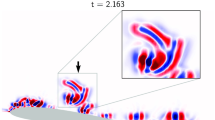Summary
Karhunen-Loève expansion and snapshot POD are based on principal component analysis of series of data. They provide basis vectors of the subspace spanned by the data. All the data must be taken into account to find the basis vectors. These methods are not convenient for any improvement of the basis vectors when new data are added into the data base. We consider the data as a state evolution and we propose an incremental algorithm to build basis functions for the decomposition of this state evolution. The proposed algorithm is based on the APHR method (A Priori Hyper-Reduction method). This is an adaptive strategy to build reduced order model when the state evolution is implicitely defined by non-linear governing equations. In case of known state evolutions the APHR method is an incremental Karhunen-Loève decomposition. This approach is very convenient to expand the subspace spanned by the basis functions. In the first part of the present paper the main concepts related to the “a priori” model reduction technique are revisited, as a previous task to its application in the cases considered in the next sections.
Some engineering problems are defined in domains that evolve in time. When this evolution is large the present and the reference configurations differ significantly. Thus, when the problem is formulated in the total Lagrangian framework frequent remeshing is required to avoid too large distortions of the finite element mesh. Other possibility for describing these models lies in the use of an updated formulation in which the mesh is conformed to each intermediate configuration. When the finite element method is used, then frequent remeshing must be carried out to perform an optimal meshing at each intermediate configuration. However, when the natural element method, a novel meshless technique, is considered, whose accuracy does not depend significantly on the relative position of the nodes, then large simulations can be performed without any remeshing stage, being the nodal position at each intermediate configuration defined by the transport of the nodes by the material velocity or the advection terms. Thus, we analyze the extension of the “a priori” model reduc tion, based on the use in tandem of the Karhunen-Loève decomposition (that extracts significant information) and an approximation basis enrichment based on the use of the Krylov's subspaces, previously proposed in the framework of fixed mesh simulation, to problems defined in domains evolving in time.
Finally, for illustrating the technique capabilities, the “a priori” model reduction will be applied for solving the kinetic theory model which governs the orientation of the fibers immersed in a Newtonian flow.
Similar content being viewed by others
References
A. Ammar and F. Chinesta (2004). A particle strategy for solving the Fokker-Planck equation governing the fiber orientation distribution in steady recirculating flows involving short fiber suspensions.Lectures Notes on Computational Science and Engng. Springer,43, 1–16.
G. P. Brooks and J. M. Powers (2002). A Karhunen-Loève Galerkin Technique with Shock Fitting for Optimization of a Blunt Body Geometry. In38th AIAA/ASME/SAE/ASEE Joint Propulsion Conference and exibit. Indianapolis, IN.
F. Chinesta, G. Chaidron and A. Poiton (2003). On the solution of the Fokker-Planck equations in steady recirculating flows involving short fiber suspensions.Journal of Non-Newtonian Fluid Mechanics,113(2–3), 97–125.
E. Cueto, M. Doblaré and L. Gracia (2000). Imposing essential boundary conditions in the Natural Element Method by means of density-scaled α-shapes.International Journal for Numerical Methods in Engineering,49(4), 519–546.
E. Cueto, N. Sukumar, B. Calvo, J. Cegonino and M. Doblaré (2003). Overview and recent advances in Natural Neighbour Galerkin methods.Archives of Computational Methods in Engineering,10(4), 307–384.
M. Fahl (2001). Computation of POD Basis Functions for Fluid Flows with Lanczos Methods.Mathematical and Computer Modeling,34, 91–107.
P.J. Holmes, J.L. Lumleyc, G. Berkoozld, J.C. Mattinglya and R.W. Wittenberg (1997). Lowdimensional models of coherent structures in turbulence.Physics Reports,287.
K. Karhunen (1946). Uber lineare methoden in der wahrscheinlichkeitsrechnung.Ann. Acad. Sci. Fennicae, ser. Al. Math. Phys.,37.
P. Krysl, S. Lall and J.E. Marsden (2001). Dimensional model reduction in non-linear finite element dynamics of solids and structures.Int. J. Numer. Meth. in Engng.,51, 479–504.
M. M. Loève (1963).Probability theory. The University Series in Higher Mathematics, 3rd Ed. Van Nostrand, Princeton, NJ.
E. N. Lorenz (1956).Empirical Orthogonal Functions and Statistical Weather Predictron. MIT. Departement of Meteorology, Scientific Report N1, Statistical Forecasting Project.
M. A. Martínez, E. Cueto, M. Doblaré and F. Chinesta (2003). Natural Element meshless simulation of injection processes involving short fiber suspensions.Journal of Non Newtonian Fluid Mechanics,115, 51–78.
H. M. Park and D. H. Cho (1996). The Use of the Karhunen-Loève Decomposition for the Modelling of Distributed Parameter Systems.Chem. Engineer. Science. 51, 81–98.
D. Ryckelynck (2005). A priori hypereduction method: an adaptive approach.Journal of Computational Physics,202, 346–366.
L. Sirovich (1987). Turbulence and the dynamics of coherent structures part I: coherent structures.Quaterly of applied mathematics,XLV, 561–571.
N. Sukumar, B. Moran and T. Belytschko (1998). The Natural Element Method in Solid Mechanics.International Journal for Numerical Methods in Engineering,43(5), 839–887.
Author information
Authors and Affiliations
Corresponding author
Rights and permissions
About this article
Cite this article
Ryckelynck, D., Chinesta, F., Cueto, E. et al. On thea priori model reduction: Overview and recent developments. Arch Computat Methods Eng 13, 91–128 (2006). https://doi.org/10.1007/BF02905932
Received:
Issue Date:
DOI: https://doi.org/10.1007/BF02905932




